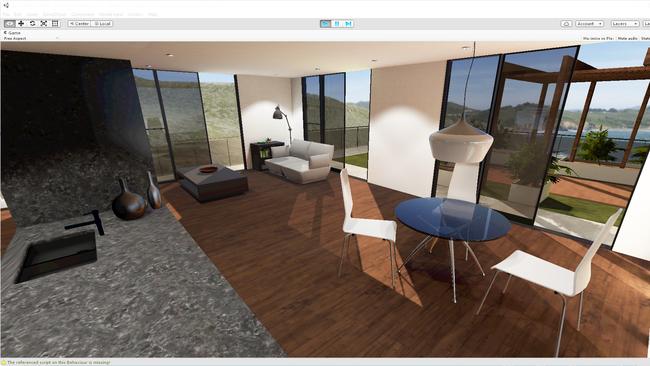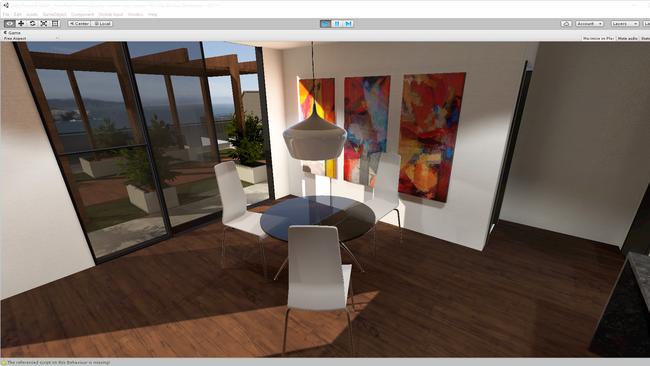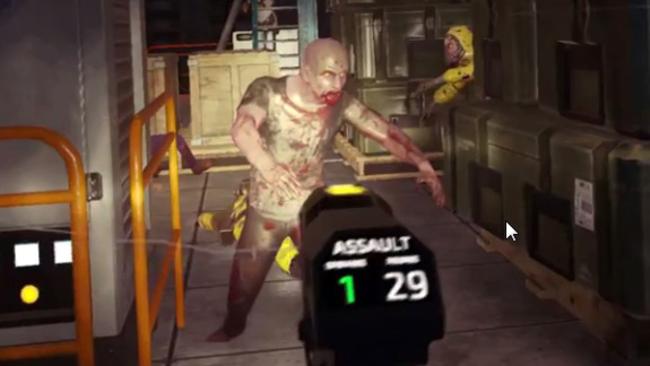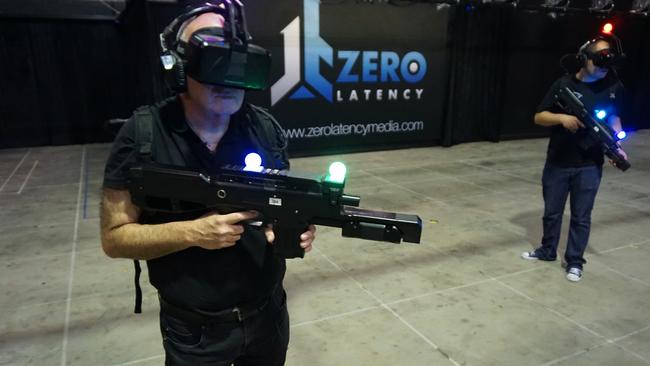Zero Latency’s virtual reality adds new dimension to real estate
Prospective buyers can independently tour properties in an imaginary world.
I’m walking in virtual space around an apartment that isn’t here. Yet here I am, crossing the kitchen and stepping on to a balcony, where I stop to admire the ocean views.
Proceeding along the balcony, I pass a small garden and enter a bedroom, then back to the kitchen. I like the place. Would I buy it?
It looks real enough, but this place is literally other-worldly. In this, the real world, I’m trudging around an empty warehouse in North Melbourne accompanied by architects Rob Howden and Timms Holden, wearing a virtual reality headset and looking a dork.
Welcome to the latest real estate marketing tool: virtual walking tours of homes and apartments that are far away, perhaps overseas, or a figment of the imagination — that exist simply on a plan.
Virtual reality is not a new idea in real estate marketing. Some companies let you put on a VR headset, sit in a chair and view a series of immersive 3-D photos. It’s similar to what Google Street View offers.
You lunge from 360-degree still image to image. Or you sit in a chair watching a 360-degree video. It’s immersive, but you are a shackled spectator.

This new experience, developed by start-up Zero Latency, is a huge step up. It’s free-roam virtual reality and you walk independently — in Zero Latency’s 400sq m empty warehouse — in an imaginary world.
Founded by Tim Ruse, Scott Vandonkelaar and Kyle Smith, Zero Latency initially received funding of $29,700 through crowdsourcing site pozible.com. One of its backers was REA Group (majority-owned by News Corp Australia, publisher of The Australian); another, venture capital firm Carthona Capital, which poured in $1 million.
Bizarrely, this real estate experience grew from a game about slaughtering zombies in an apocalyptic world.
“Zombies were easy to code,” Ruse tells The Australian, pointing out that he and his partners were IT professionals and not from the gaming industry.
In fact, while we were at Zero Latency trying out some in virtual killing (see story at right) along with our real estate tour, the staff managed to fit in a Buddhist-inspired relaxation session. Wiping out zombies, it seems, can be perfectly Zen.
Computer code developed for one application often can be adapted to applications that seem far removed. In this case, the code that lets you walk around an apocalyptic scene with guns was repurposed so you could shuffle around a virtual house or apartment. And code that allows gamers in the apocalyptic world to see each other is being adapted so that a buyer can see a real estate agent when they’re both in the virtual world.
In future, as internet speeds improve, a buyer viewing a virtual apartment in China could be negotiating with a real estate agent in Sydney, but both would appear beside each other in the virtualised apartment. Selling Australian apartments off the plan in China is an obvious application.

REA Group innovation team leader Luke Chadwick says buyers typically might go to a VR facility and walk through eight apartments in five minutes. They might settle on two to visit physically before buying. He envisages the virtualised apartments will be mostly off the plan.
In a virtual apartment you can change the layout, move the furniture and replace the pictures on the wall to get the perfect setting. The software also performs tricks. When it’s a two-storey house, the buyer enters a lift and is given the illusion of travelling upwards. The software also can slightly bend virtual space to fit a larger design in a smaller area.
As brilliant as VR walking tours are, they have limits. A walking virtual tour of a home wouldn’t replicate the stench from a vinyl factory up the road or tell you that your next-door neighbours rev their bikes at 7am on Sundays and perform wheelies at 11pm daily.
Chadwick says it is possible to include views from windows, though no one can guarantee those views will be there when an off-the-plan apartment becomes reality. “But it is possible to capture the external environment with a drone,” he says.
Still, the realism of the virtual apartment is amazing. Chadwick and his team even try to replicate the correct angles of shadows during daylight. Of course, the apartment fixtures are illusionary. You can walk through walls and even over balconies to view the building from afar, but your body, which reacts instinctively, may not like the experience.
Chadwick says the cost of building a virtual apartment starts at about $10,000. REA Group uses computer-aided design files and rendered artwork. “Some of the stuff we’ve done would have been trivial but the client said: ‘No, no, I must have shadows in the mirrors.’ They can be very picky.”
In the real estate industry, the model is simple. REA Group will sell the experience to developers, who then will invite buyers to view it. That could prove attractive to some developers but others might regard it as an unnecessary expense for hooking clients.
News Corp Australia, meanwhile, has taken a majority stake in Diakrit, a Thai software company that also specialises in building 3-D models. Its offering will be integrated into the REA Group VR experience.
As for Zero Latency, the team is looking at other VR applications. These include training military personnel and firefighters, and experiences such as walking through an oil rig or a shopping centre before it is built.

Among the undead
After a good session of virtual house-hunting in the warehouse, it’s time for a little zombie-killing. I put on a VR headset and backpack and enter the game along with architects Rob Howden and Timms Holden.
There’s some target practice using our VR weapons before we’re spectacularly lifted three storeys to the surface. It’s an illusion, of course, as we don’t move at all. And here come the zombies — we gradually become efficient at reloading the weapons and covering one another.
The game is version 3 for Zero Latency, which spent more than three years developing and testing games. Players pay $88 to be in a team of six, appearing to each other in the virtual world as avatars dressed in military garb.
Zero Latency has achieved a series of firsts with this technology. The Oculus Rift headsets the company uses usually connect to a computer by cable. That means no mobility. It circumvented this problem by connecting the headset to a Dell Alienware laptop and housing it in a lightweight backpack worn by the player. The team has written computer code that tracks each person’s motion 60 times a second and shows users where each of them is in VR.
“You have to pick your battles as to what you want to develop in technology,” says Zero Latency co-founder Tim Ruse. “There was no integrated tracking system made for VR.”
The company will roll out the experience globally from July 1. “We’ve got some great people in Tokyo and in the US,” Ruse says, adding that the experience will also be available in China and around Australia.




To join the conversation, please log in. Don't have an account? Register
Join the conversation, you are commenting as Logout